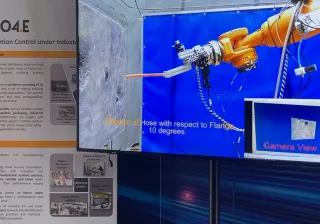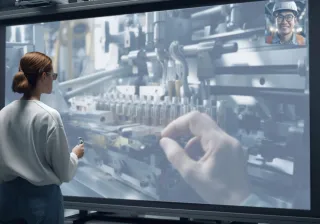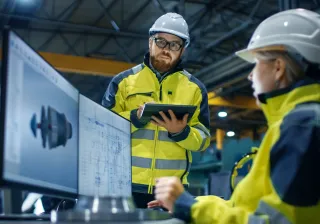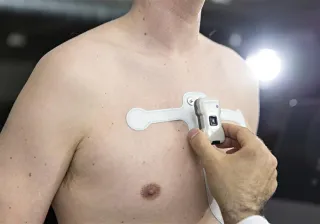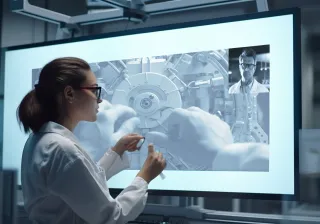Transformation of industrial work

Global economic uncertainties have led to widespread resignations and labour shortages, especially in jobs perceived as unfulfilling or vulnerable to economic fluctuation. Growing competition, rising energy prices and the need to achieve the objectives for sustainable development accelerate the transformation of industry. The industry must therefore become more networked, the level of automation must be further increased, and the outcome and quality of work must be optimised by means of smart technology. With VTT’s expertise, you can modify current jobs and create new ones to make working in the industry safe, satisfying and appealing in the decades to come.
Key facts: transformation of industrial work
To attract the best experts, we need to focus on employee well-being and freedom of choice in industrial jobs. New technologies are not intrinsic but help to achieve the objectives of work and solve challenges.
Employee well-being increases when work is tailored to the capabilities, skills and preferences of individual workers.
As humans continue to play an important part in industry, increasing the well-being of workers improves productivity and social sustainability.

Transformation of industrial work is already happening
The digital and green transitions are profoundly changing the way we work. For example, more and more manual work is done by robots and machines, whereas the role of humans is evolving more towards monitoring, observing and analysing. This is shown in our Industrial Dream Jobs handbook as well.
The change is noticeable outside of manufacturing sites and production lines too. For example, at modern airports, we no longer show our boarding pass to a human but to a scanner. Smart buildings are monitored by connected sensors and artificial intelligence instead of regular check-ups done by humans. Public transport buses and trams are becoming autonomous, remotely monitored and operated by distant supervisors.
However, external economic factors such as the pandemic have left many people unhappy with their jobs. This has caused waves of resignations globally as people are gravitating to jobs that offer more long-term security or more meaning, for example.
To make industrial work more appealing in general and to attract the best in your industry, fresh thinking is needed. How can you modify and combine existing jobs to make them more fulfilling – and as a result, more productive? How can you use technology to help people carry out new, interesting tasks?
To answer these questions and to prepare your organisation for the transformation of industrial work, you need to start with employee well-being.
How to create jobs people will love?
Start with the people. New technologies have emerged and will keep emerging in the future. Unfortunately, many technology trials remain trials without operational impact throughout the organisations. Technology must not be an end in itself, but rather procurement and use of technology must be designed in accordance with the requirements, so that the maximum benefit of the technology is achieved in line with the objectives. The use and the technical solution are planned simultaneously - both are part of the same entity, so it is not worth planning them separately. When machines start to perform monotonous or dirty tasks, the tasks and roles of people have to be completely redesigned.
Thus, you need to place humans at the centre of the larger systemic changes. A human-first approach helps incorporate processes and technology that will help employees thrive – on the factory floor, behind the wheel of the forklift at the warehouse, and everywhere else. A happy workforce utilising modern technologies in their work is also your best calling-card when hiring new staff.
What could industrial dream jobs look like?
Get a sneak-peek of future industrial jobs by browsing our Industrial Dream Jobs pocketbook. It describes six personas with interesting new jobs.
Human-centric approach to transformation of industrial work
Technology should streamline people's work and adapt to their needs, not the other way around. The matter can be viewed from many points of view, for example from the perspective of the working environment, the employee or the work practices (Picture 1).
The impact of technology can be diverse. For example, AI can be used to design work so that tasks are rotated fairly and the teams are selected so that working together is comfortable and productive. AI can also guide workers, for example, so that they can save, say, 10% energy by making a particular choice.
As another example of technology adapting to human needs, empathetic computing includes tools for monitoring an individual’s stress levels through, for example, heart rate and the temperature and micro-movements of the body. In the future, this data can be used to optimise the workload and tasks of the individual for the day as well as ensuring safe working. You can take on the big challenges when you are in a real flow state, instead of when you’ve just eaten a pizza for big lunch.
There are far more examples of where technology can improve employee well-being. Robots are happy to work in dull, dirty or dangerous locations. Augmented and virtual reality solutions can improve visual perception of different environments and AI supports people in decision making.

Picture 1. VTT views change in work holistically
Multidisciplinary expertise in creating more enjoyable jobs
At VTT, we are experts in finding new ways for people, organisations and machines to collaborate with each other. We can help you pinpoint the opportunities – and the threats – that the transformation of industrial work creates.
Collaborate with us to create future-proof teams with motivated and capable remote and on-site employees.
How to work with us
-
Current state analysis
Understanding the current situation is a good basis for planning. By analysing current work and user experience, we can build an understanding of development needs and objectives. -
Future vision
Together, we will create a vision for the future on how to better achieve your goals. These goals could be speed or quality of production, employee well-being, safety, energy efficiency, waste minimisation or even circular economy goals. -
Roadmap
We help you identify your objectives more precisely by identifying requirements from a human performance perspective: for example, what your employees need to be able to do better with new technology. What are the existing and emerging operational challenges that will be better addressed by new technologies? -
Detailed plan
We help to promote selected development targets in the planning of both use and technology acquisition and implementation. We design both the use and the technical solution at the same time and finally help assess whether the desired benefits were achieved with the new technologies.
Leading expertise in the transformation of industrial work
We bring together specialists from different fields to provide a comprehensive view of the future of industrial work.

Mikael Wahlström is Research Team Leader of human factors team at VTT Technical Research Centre of Finland. He has PhD in Social Psychology and title of Docent in Social Sciences at the University of Helsinki. His research experience within human factors covers various work contexts, including nuclear power plant operations, maintenance work, manufacturing industry, robotic surgery and marine navigation. He has done task-analysis for technology concept development and for training development. His studies on human–technology interaction cover autonomous systems, virtual reality, robotics and artificial intelligence. He has first author publications on top and leading journals on human–computer interaction and design studies.

Susanna Aromaa is a senior scientist in Human Factors in Work Transformation team. She has co-created, designed and evaluated new ways of working utilizing emerging technologies (e.g., augmented and virtual reality systems, robotics) in industrial work context. Dr. Aromaa has participated in many EU and national projects and researched human factors and ergonomics in design of industrial workplaces especially when implementing novel technologies. She is interested of the acceptance and user experience of new technologies.

Karoliina Salminen has led VTT’s vision work towards autonomous manufacturing. She is responsible for the smart manufacturing framework at VTT, which means she continuously works together with several companies and other stakeholders to build a sustainable industry through increased automation and digitalization. Karoliina is especially interested in human-centric manufacturing with enabling technologies and new work roles.
Contact us here!
Video: Industrial Dream Jobs


